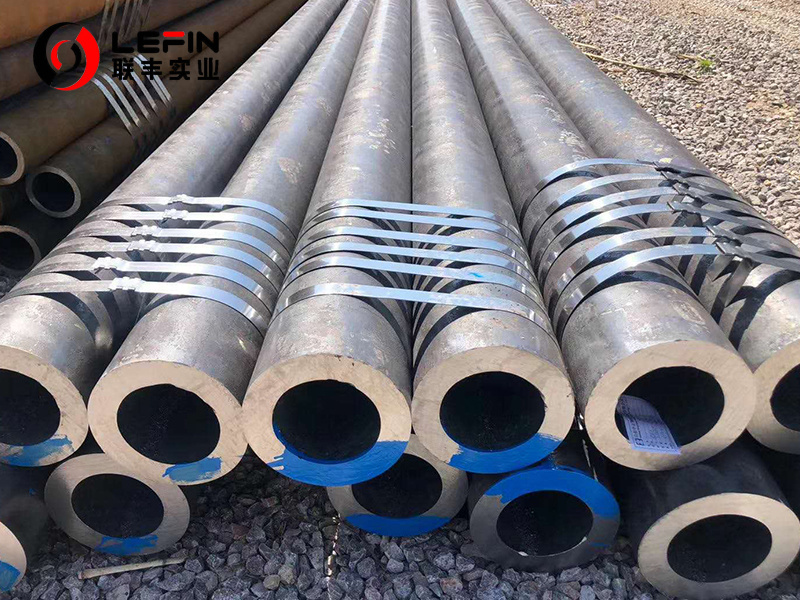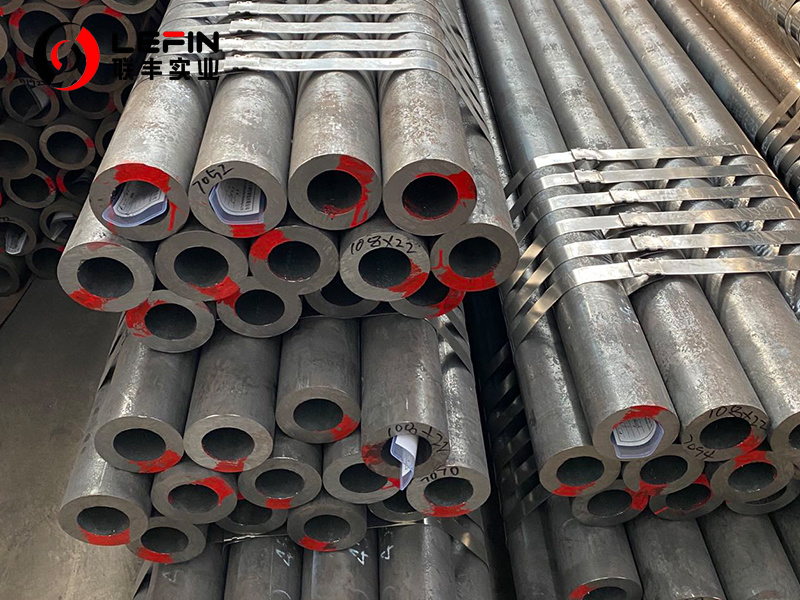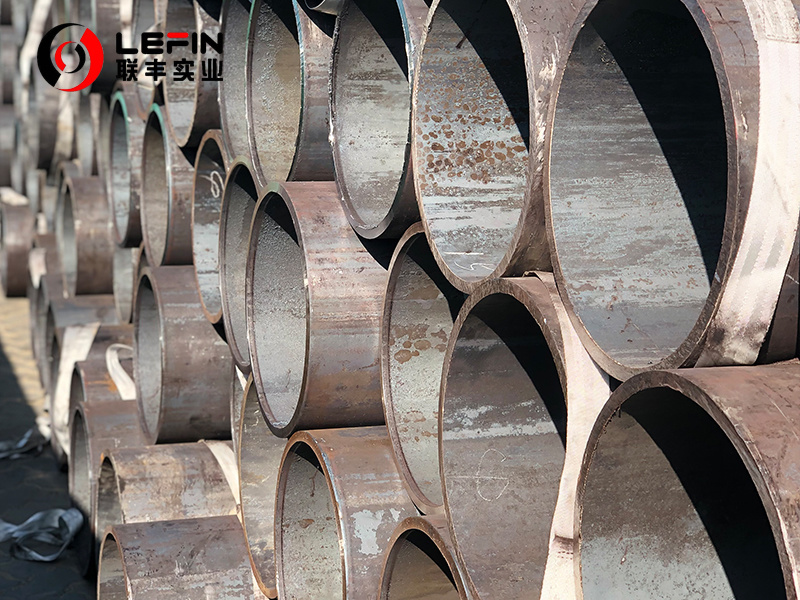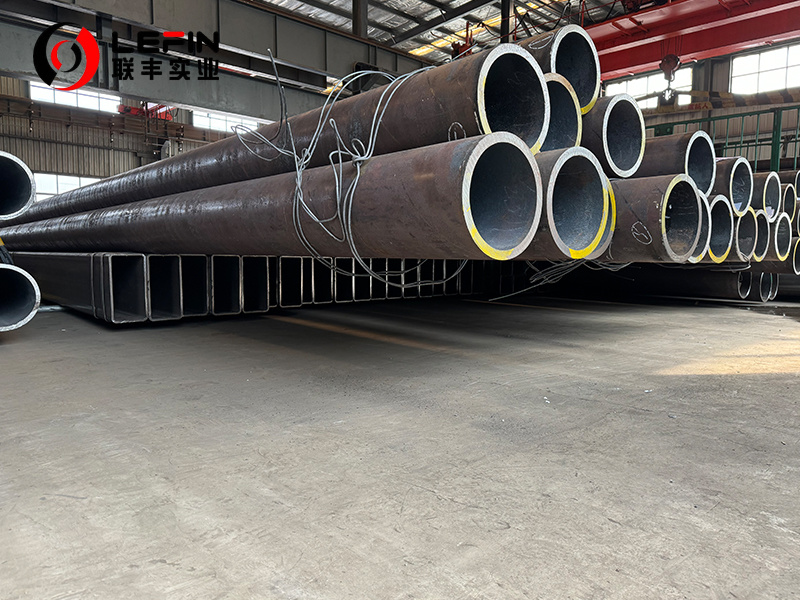



- Details
-
Standard
Governed by ASTM A106 / A106M (Metric version) standard.Covers seamless carbon steel pipe intended for high-temperature service.
Typical applications include:
Power generation (boilers, superheaters)
Petrochemical & hydrocarbon processing plants
Refineries
Steam lines
Pressure vessels
Other systems involving high-pressure and high-temperature fluids (water, oil, gas, steam).
Material & Manufacturing
Base Material: Carbon steel.Manufacturing Process: Pipes are produced seamlessly, meaning they are formed from a solid cylindrical steel billet without any longitudinal weld seam. Common methods include:
●Rotary Piercing (Mannesmann Process): A hot billet is pierced by rolls to form a hollow shell, then elongated and sized.
●Extrusion: Forcing hot metal through a die.
Heat Treatment: Pipes are supplied in one of three conditions, depending on the grade and size:●Hot-Finished (as-rolled): No subsequent heat treatment after the final hot-forming pass.
●Cold-Drawn: Followed by a stress-relieving heat treatment.
●Heat Treated (Normalized, Normalized & Tempered, or Annealed): Performed after hot-forming to achieve required mechanical properties and microstructure. Grade C must be heat treated for all sizes.
Grade
Three grades define minimum mechanical properties and chemical composition:Grade
Tensile Strength (min)
Yield Strength (min)
Chemical Composition Focus
Common Use Case
A
48 ksi (330 MPa)
30 ksi (205 MPa)
Moderate strength, general service
Lower pressure/temp steam lines
B
60 ksi (415 MPa)
35 ksi (240 MPa)
Higher strength, most common grade
High-pressure steam, general HS
C
70 ksi (485 MPa)
40 ksi (275 MPa)
Highest strength, stricter carbon/sulfur limits
High-pressure/temp critical lines
Dimensions & Tolerances
Sizes: Covers nominal pipe sizes (NPS) from 1/8 inch to 48 inches.Wall Thickness: Available in standard (STD), extra-strong (XS), and double extra-strong (XXS) schedules, as well as other specified wall thicknesses. Dimensions and tolerances (OD, Wall Thickness, Length, Straightness) are specified in ASME B36.10M.

Chemical Composition (Key Elements - Max % Unless Range Given)
Element
Grade A
Grade B
Grade C
Notes
C
0.25
0.30
0.35
Max carbon. Affects strength, weldability, hardenability.
Mn
0.27 - 0.93
0.29 - 1.06
0.29 - 1.06
Manganese range. Increases strength, improves hardenability.
P
0.035
0.035
0.035
Phosphorus max. Impurity, reduces toughness, promotes segregation.
S
0.035
0.035
0.035
Sulfur max. Impurity, reduces ductility & toughness (forms sulfides).
Si
0.10 min
0.10 min
0.10 min
Silicon min. Deoxidizer (killed steel), increases strength.
Cr
0.40
0.40
0.40
Chromium max. Added for heat resistance in other alloys.
Cu
0.40
0.40
0.40
Copper max. Impurity/corrosion resistance.
Mo
0.15
0.15
0.15
Molybdenum max. Added for creep strength in other alloys.
Ni
0.40
0.40
0.40
Nickel max. Impurity/toughness in other alloys.
V
0.08
0.08
0.08
Vanadium max. Added for strength in microalloyed steels.
Unless otherwise specified by the purchaser, for each reduction of 0.01% below the specified carbon maximum, an increase of 0.06% manganese above the specified maximum will be permitted up to a maximum of 1.65% (1.35% for ASME SA106).
Mechanical Properties (Room Temperature)
Property
Grade A
Grade B
Grade C
Tensile Strength (min)
48,000 psi (330 MPa)
60,000 psi (415 MPa)
70,000 psi (485 MPa)
Yield Strength (min)
30,000 psi (205 MPa)
35,000 psi (240 MPa)
40,000 psi (275 MPa)
Elongation (min)
See Note Below
See Note Below
See Note Below
Elongation: Minimum % elongation in 2 inches (50mm) depends on wall thickness and is calculated by formula in the standard. Generally decreases as wall thickness increases.

Hydrostatic Testing
Mandatory: Every pipe must undergo a hydrostatic test without leakage.Test Pressure: Calculated using the formula: P = 2St / D
P = Minimum hydrostatic test pressure (psi or MPa)
S = Allowable stress (60% of specified min yield strength for the grade)
t = Specified wall thickness (in or mm)
D = Specified outside diameter (in or mm)
Duration: Pressure must be held for a minimum of 5 seconds.
Nondestructive Examination (NDE)
ASTM A106 itself does not mandate specific NDE (like ultrasonic or radiographic testing) beyond the hydrostatic test.However, supplementary requirements (designated "S" options, e.g., S1, S2, S3, S4, S5, S6) can be specified in the purchase order to require additional NDE methods like:
Ultrasonic Testing (UT): For detection of longitudinal imperfections.
Radiographic Testing (RT): For detection of volumetric imperfections (less common for seamless than welded).
Electromagnetic Testing (ET): For surface imperfections.
Leak Testing.
Key Distinguishing Features Summary
Seamless Construction: No welded seam, offering inherent strength and pressure integrity.Carbon Steel: Primarily iron, carbon, and manganese.
High-Temperature Service: Designed for elevated temperatures and pressures.
Three Strength Grades: A (lowest), B (most common), C (highest).
Mandatory Hydrostatic Test: Ensures leak-tightness under pressure.
Strict Chemical & Mechanical Requirements: Ensures performance and weldability.
Broad Application: Foundational piping material in power, oil & gas, and process industries.
This specification ensures the pipe is suitable for demanding environments where reliability under thermal and mechanical stress is critical.
Q&As About ASTM A106 Seamless Carbon Steel Pipe
Q1: Can ASTM A106 Pipe Be Substituted With ASTM A53 Pipe?
A1: While Both Are Carbon Steel Pipes, Substitution Is Not Automatic And Depends On The Application.
●A106 is specifically designed for high-temperature service (e.g., steam lines, boilers, refinery process lines) and has stricter chemical requirements (especially sulfur) and mandatory heat treatment for Grade C.
●A53 is intended for lower-temperature, general-purpose applications (e.g., plumbing, structural, low-pressure steam). It can be seamless (Type S) or welded (Type E or F). Its chemical requirements are generally less stringent.
Key Difference: A106 has guaranteed elevated temperature yield strength properties (detailed in supplementary tables in the standard), while A53 does not. Substituting A53 for A106 in high-temperature service can be unsafe and violate code requirements.Q2: What Are The Critical Considerations For Welding ASTM A106 Pipe?
A2: Welding A106 Requires Attention To:
●Material Preparation: Remove all mill scale, rust, paint, oil, and moisture from the weld area. Proper beveling is essential.
●Preheat: Often required, especially for thicker walls and higher carbon content (e.g., Grade C). Preheat minimizes the risk of hydrogen-induced cracking (HIC) and hard zones in the Heat-Affected Zone (HAZ). The specific preheat temperature depends on wall thickness, carbon equivalent (CE), and ambient conditions (refer to AWS D1.1 or applicable welding procedure specification).
●Carbon Equivalent (CE): Higher CE (calculated from C, Mn, Cr, Mo, V, Ni, Cu content) increases hardenability and crack susceptibility. Grades B and C generally have higher CE than Grade A, requiring stricter welding controls (preheat, interpass temp, post-weld heat treatment).
●Filler Metal Selection: Use low-hydrogen electrodes or filler metals (e.g., E7018) suitable for carbon steel and the service conditions (temperature, pressure). Match the strength level (e.g., use filler metal rated for 70 ksi min tensile for Grade C).
●Post-Weld Heat Treatment (PWHT): May be required by the applicable construction code (e.g., ASME B31.1, B31.3) based on material thickness (P-No. 1 curves) and service conditions to relieve residual stresses and temper hard microstructures. Always follow a qualified Welding Procedure Specification (WPS).


ASTM A106 Seamless Carbon Steel Pipe
Subcategory
Keyword
- Details
-
Standard
Governed by ASTM A106 / A106M (Metric version) standard.Covers seamless carbon steel pipe intended for high-temperature service.
Typical applications include:
Power generation (boilers, superheaters)
Petrochemical & hydrocarbon processing plants
Refineries
Steam lines
Pressure vessels
Other systems involving high-pressure and high-temperature fluids (water, oil, gas, steam).
Material & Manufacturing
Base Material: Carbon steel.Manufacturing Process: Pipes are produced seamlessly, meaning they are formed from a solid cylindrical steel billet without any longitudinal weld seam. Common methods include:
●Rotary Piercing (Mannesmann Process): A hot billet is pierced by rolls to form a hollow shell, then elongated and sized.
●Extrusion: Forcing hot metal through a die.
Heat Treatment: Pipes are supplied in one of three conditions, depending on the grade and size:●Hot-Finished (as-rolled): No subsequent heat treatment after the final hot-forming pass.
●Cold-Drawn: Followed by a stress-relieving heat treatment.
●Heat Treated (Normalized, Normalized & Tempered, or Annealed): Performed after hot-forming to achieve required mechanical properties and microstructure. Grade C must be heat treated for all sizes.
Grade
Three grades define minimum mechanical properties and chemical composition:Grade
Tensile Strength (min)
Yield Strength (min)
Chemical Composition Focus
Common Use Case
A
48 ksi (330 MPa)
30 ksi (205 MPa)
Moderate strength, general service
Lower pressure/temp steam lines
B
60 ksi (415 MPa)
35 ksi (240 MPa)
Higher strength, most common grade
High-pressure steam, general HS
C
70 ksi (485 MPa)
40 ksi (275 MPa)
Highest strength, stricter carbon/sulfur limits
High-pressure/temp critical lines
Dimensions & Tolerances
Sizes: Covers nominal pipe sizes (NPS) from 1/8 inch to 48 inches.Wall Thickness: Available in standard (STD), extra-strong (XS), and double extra-strong (XXS) schedules, as well as other specified wall thicknesses. Dimensions and tolerances (OD, Wall Thickness, Length, Straightness) are specified in ASME B36.10M.

Chemical Composition (Key Elements - Max % Unless Range Given)
Element
Grade A
Grade B
Grade C
Notes
C
0.25
0.30
0.35
Max carbon. Affects strength, weldability, hardenability.
Mn
0.27 - 0.93
0.29 - 1.06
0.29 - 1.06
Manganese range. Increases strength, improves hardenability.
P
0.035
0.035
0.035
Phosphorus max. Impurity, reduces toughness, promotes segregation.
S
0.035
0.035
0.035
Sulfur max. Impurity, reduces ductility & toughness (forms sulfides).
Si
0.10 min
0.10 min
0.10 min
Silicon min. Deoxidizer (killed steel), increases strength.
Cr
0.40
0.40
0.40
Chromium max. Added for heat resistance in other alloys.
Cu
0.40
0.40
0.40
Copper max. Impurity/corrosion resistance.
Mo
0.15
0.15
0.15
Molybdenum max. Added for creep strength in other alloys.
Ni
0.40
0.40
0.40
Nickel max. Impurity/toughness in other alloys.
V
0.08
0.08
0.08
Vanadium max. Added for strength in microalloyed steels.
Unless otherwise specified by the purchaser, for each reduction of 0.01% below the specified carbon maximum, an increase of 0.06% manganese above the specified maximum will be permitted up to a maximum of 1.65% (1.35% for ASME SA106).
Mechanical Properties (Room Temperature)
Property
Grade A
Grade B
Grade C
Tensile Strength (min)
48,000 psi (330 MPa)
60,000 psi (415 MPa)
70,000 psi (485 MPa)
Yield Strength (min)
30,000 psi (205 MPa)
35,000 psi (240 MPa)
40,000 psi (275 MPa)
Elongation (min)
See Note Below
See Note Below
See Note Below
Elongation: Minimum % elongation in 2 inches (50mm) depends on wall thickness and is calculated by formula in the standard. Generally decreases as wall thickness increases.

Hydrostatic Testing
Mandatory: Every pipe must undergo a hydrostatic test without leakage.Test Pressure: Calculated using the formula: P = 2St / D
P = Minimum hydrostatic test pressure (psi or MPa)
S = Allowable stress (60% of specified min yield strength for the grade)
t = Specified wall thickness (in or mm)
D = Specified outside diameter (in or mm)
Duration: Pressure must be held for a minimum of 5 seconds.
Nondestructive Examination (NDE)
ASTM A106 itself does not mandate specific NDE (like ultrasonic or radiographic testing) beyond the hydrostatic test.However, supplementary requirements (designated "S" options, e.g., S1, S2, S3, S4, S5, S6) can be specified in the purchase order to require additional NDE methods like:
Ultrasonic Testing (UT): For detection of longitudinal imperfections.
Radiographic Testing (RT): For detection of volumetric imperfections (less common for seamless than welded).
Electromagnetic Testing (ET): For surface imperfections.
Leak Testing.
Key Distinguishing Features Summary
Seamless Construction: No welded seam, offering inherent strength and pressure integrity.Carbon Steel: Primarily iron, carbon, and manganese.
High-Temperature Service: Designed for elevated temperatures and pressures.
Three Strength Grades: A (lowest), B (most common), C (highest).
Mandatory Hydrostatic Test: Ensures leak-tightness under pressure.
Strict Chemical & Mechanical Requirements: Ensures performance and weldability.
Broad Application: Foundational piping material in power, oil & gas, and process industries.
This specification ensures the pipe is suitable for demanding environments where reliability under thermal and mechanical stress is critical.
Q&As About ASTM A106 Seamless Carbon Steel Pipe
Q1: Can ASTM A106 Pipe Be Substituted With ASTM A53 Pipe?
A1: While Both Are Carbon Steel Pipes, Substitution Is Not Automatic And Depends On The Application.
●A106 is specifically designed for high-temperature service (e.g., steam lines, boilers, refinery process lines) and has stricter chemical requirements (especially sulfur) and mandatory heat treatment for Grade C.
●A53 is intended for lower-temperature, general-purpose applications (e.g., plumbing, structural, low-pressure steam). It can be seamless (Type S) or welded (Type E or F). Its chemical requirements are generally less stringent.
Key Difference: A106 has guaranteed elevated temperature yield strength properties (detailed in supplementary tables in the standard), while A53 does not. Substituting A53 for A106 in high-temperature service can be unsafe and violate code requirements.Q2: What Are The Critical Considerations For Welding ASTM A106 Pipe?
A2: Welding A106 Requires Attention To:
●Material Preparation: Remove all mill scale, rust, paint, oil, and moisture from the weld area. Proper beveling is essential.
●Preheat: Often required, especially for thicker walls and higher carbon content (e.g., Grade C). Preheat minimizes the risk of hydrogen-induced cracking (HIC) and hard zones in the Heat-Affected Zone (HAZ). The specific preheat temperature depends on wall thickness, carbon equivalent (CE), and ambient conditions (refer to AWS D1.1 or applicable welding procedure specification).
●Carbon Equivalent (CE): Higher CE (calculated from C, Mn, Cr, Mo, V, Ni, Cu content) increases hardenability and crack susceptibility. Grades B and C generally have higher CE than Grade A, requiring stricter welding controls (preheat, interpass temp, post-weld heat treatment).
●Filler Metal Selection: Use low-hydrogen electrodes or filler metals (e.g., E7018) suitable for carbon steel and the service conditions (temperature, pressure). Match the strength level (e.g., use filler metal rated for 70 ksi min tensile for Grade C).
●Post-Weld Heat Treatment (PWHT): May be required by the applicable construction code (e.g., ASME B31.1, B31.3) based on material thickness (P-No. 1 curves) and service conditions to relieve residual stresses and temper hard microstructures. Always follow a qualified Welding Procedure Specification (WPS).


Related products
Product Consulting

Address: Hengtai Road,Daqiuzhuang Town,Jinghai County,Tianjin,China
Mob: +8615122229899(whatspp)
Phone: +86 22 58171905
Fax: +86 22 58171902
E-mail:info@lefinsteel.com
Get company updates

Tianjin Lefin Industrial Co.,Ltd. All rights reserved City sub-station SEO www.300.cn

